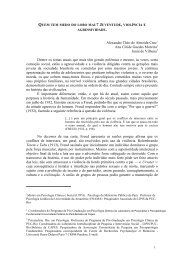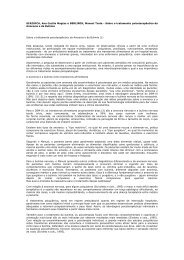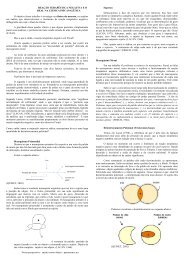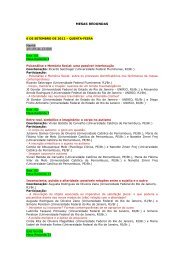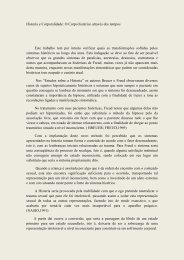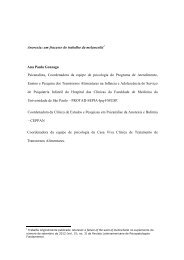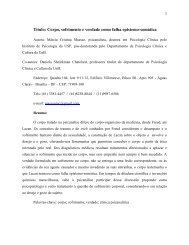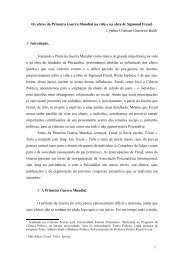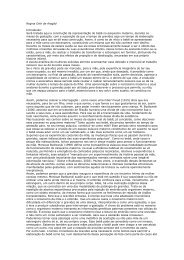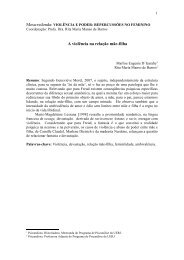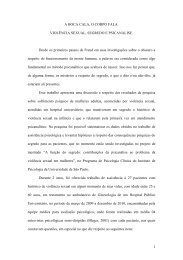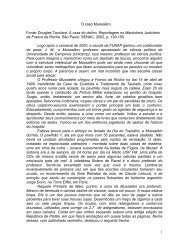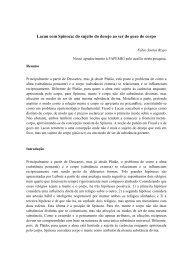James Phillips Introduction For those of you not famil
James Phillips Introduction For those of you not famil
James Phillips Introduction For those of you not famil
You also want an ePaper? Increase the reach of your titles
YUMPU automatically turns print PDFs into web optimized ePapers that Google loves.
11Ideology, Violence, and Psychopathology: The Case <strong>of</strong> the “Unabomber”<strong>James</strong> <strong>Phillips</strong><strong>Introduction</strong><strong>For</strong> <strong>those</strong> <strong>of</strong> <strong>you</strong> <strong>not</strong> <strong>famil</strong>iar with the case, Theodore Kaczynski is an American citizenwho terrorized the country for 17 years by sending mail bombs in a personal campaign againstmodern technology. In his isolated cabin in the mountains <strong>of</strong> Montana Kaczynski had developedan extended critique <strong>of</strong> modern technology, and beginning in 1978 he began a career <strong>of</strong> violencetoward individuals whom he identified as representative <strong>of</strong> the technological society. Finally, in1995, after wounding and murdering several individuals with mail bombs, and establishing hisreputation as their perpetrator, referred to by the media as the “Unabomber,” he wrote a letter tothe New York Times and Washington Post, the two most prominent newspapers in the country,declaring that he would desist in his terrorist activities if they would agree to publish his text,“Industrial Society and its Future,” also known as the “Manifesto,” a 35,000 word critique <strong>of</strong>modern technology. The two newspapers agreed to the terms and published the document.On April 3, 1996 Kaczynski was arrested at his cabin near Lincoln, Montana. The FBIwere led to Kaczynski by his brother, David, who recognized his brother's authorship in theManifesto published in the two newspapers. David Kaczynski made the decision to turn in hisbrother in the recognition that Ted was probably responsible for several murders and that morewould probably follow if he remained free. The arrest brought an end to the 17-year career <strong>of</strong> thethen 55 year old Unabomber, which began with a first mail bomb in 1978 and culminated onJanuary 22, 1998 with a guilty plea to 13 federal bombing <strong>of</strong>fenses resulting in the deaths <strong>of</strong>three men and serious injuries to several others.
2Theodore Kaczynski, the “Unabomber,” <strong>of</strong>fers a singularly vivid and provocative casestudy in the relationship between political extremism and psychopathology. Kaczynski issingular both in the grey area he occupies between ideology and psychopathology, on the onehand, and in the extraordinarily extensive documentation that is available through his ownwritings, 22,000 pages, and the record <strong>of</strong> the legal process that ended in his conviction, on theother.Critique <strong>of</strong> TechnologyIn this presentation I begin with a brief summary <strong>of</strong> Kaczynski’s ‘Manifesto’, and I dothat for a specific purpose - to establish from the outset Kaczynski’s credentials as an articulate,thoughtful critic <strong>of</strong> contemporary industrial society. In his critique he joins the company <strong>of</strong> otheranalysts <strong>of</strong> modern technology such as Jacques Ellul, whom Kaczynski has read andincorporated into his own document. I will <strong>not</strong> attempt to compare the quality <strong>of</strong> Kaczynski’swork with that <strong>of</strong> better known critics <strong>of</strong> technology. I only want establish that his critique iscarefully reasoned, stands on its own merits, and has proved prescient in many ways. The point<strong>of</strong> presenting his work at the outset is that, were I to begin with his biography and save hiscritique for later, <strong>you</strong> would be inclined to dismiss it out <strong>of</strong> hand as the work <strong>of</strong> a derangedcrank.While I will focus in this summary on the ‘Manifesto’ <strong>of</strong> 2005, Kaczynski had long beeninterested in the critique <strong>of</strong> technology and had written a shorter, equally articulate essay in1971, well before he began his career <strong>of</strong> political terrorism. The 1971 document begins: “In thesepages it is argued that continued scientific and technical progress will inevitably result in theextinction <strong>of</strong> individual liberty. I use the word ‘inevitably’ in the following sense: One might -possibly - imagine certain conditions <strong>of</strong> society in which liberty could coexist with technology,
3but these conditions do <strong>not</strong> actually exist, and we know <strong>of</strong> no way to bring them about, so that, inpractice, scientific progress will result in the extinction <strong>of</strong> individual liberty. Toward the end <strong>of</strong>this essay we propose what appears to be the only thing that bears any resemblance to a practicalremedy for this situation.” Already in this early document we see that for Kaczynski the coreissue is the relationship <strong>of</strong> modern technology and personal freedom. In the sections dealing withpersonal history we will see how that theme plays out both in his personal life and in his courtprocess.In the 1995 Manifesto, “Industrial Society and Its Future,” Kaczynski argues that modernindustrial, technological civilization alienates us from the naturally evolved process <strong>of</strong> humanlabor and satisfaction that he calls "the power process." Most people need some degree <strong>of</strong>autonomy in setting their own goals and achieving them through their own efforts, he argues,though the requirements <strong>of</strong> autonomy may be satisfied through participation in a small group thatcollaborates in attaining goals established by mutual consent. But if people work under rigidorders handed down from above or if the group that makes collective decisions is so large thatthe role <strong>of</strong> each individual is insignificant, that need for autonomy will <strong>not</strong> be satisfied.Kaczynski argues that people acquire self-confidence, self-esteem and a sense <strong>of</strong> power throughthis process <strong>of</strong> setting and attaining their own goals and when that process is aborted, theconsequences range from demoralization and loss <strong>of</strong> self-esteem to depression and anxiety and tochild abuse and eating and sleep disorders: in short, most <strong>of</strong> the ills that psychiatrists regularlytreat in our society.Such problems may also occur in simpler societies, but <strong>not</strong> on the massive scalecharacteristic <strong>of</strong> modern industrial society, which "requires people to live under conditionsradically different from <strong>those</strong> under which the human race evolved and to behave in ways
4that conflict with the patterns <strong>of</strong> behavior that the human race developed while living underearlier conditions." The density <strong>of</strong> modern urban populations since the industrial revolutionand the rapidity <strong>of</strong> social change consequent upon the pace <strong>of</strong> technological innovation havecreated a world for which evolution did <strong>not</strong> prepare us: " <strong>For</strong> primitive societies, the naturalworld (which usually changes only slowly) provided a stable framework and a sense <strong>of</strong>security. In the modern world human society dominates nature rather than the other wayaround, and modern society changes rapidly due to technological change that there is nostable framework."Kaczynski contends that the tension between our natural capacities and needs and thismodern world are unavoidable features <strong>of</strong> this system:The system has to force people to behave in ways that are increasingly remote fromthe natural pattern <strong>of</strong> human behavior....[M]odern man is strapped down by a network<strong>of</strong> rules and regulations, and his fate depends on the actions <strong>of</strong> persons remote fromhim whose decisions he can<strong>not</strong> influence. This is <strong>not</strong> accidental or a result <strong>of</strong> thearbitrariness <strong>of</strong> arrogant bureaucrats. It is necessary and inevitable in anytechnologically advanced society. The system has to regulate human behavior closelyin order to function. At work, people have to do what they are told to do, otherwiseproduction would be thrown into chaos. Bureaucracies have to be run according torigid rules. To allow any substantial personal discretion to lower-level bureaucratswould disrupt the system and lead to charges <strong>of</strong> unfairness due to differences in theway individual bureaucrats exercised their discretion. Granted, some restrictions onour freedom could be eliminated, but generally speaking, the regulation <strong>of</strong> our lives by
5large organizations is necessary for the functioning <strong>of</strong> industrial-technological society.The result is a sense <strong>of</strong> powerlessness on the part <strong>of</strong> the average person.Kaczynski invokes contemporary medicine as an example <strong>of</strong> industrialized society:Progress in medical science depends on progress in chemistry, physics, biology,computer science and other fields. Advanced medical treatments require expensive,high-tech equipment that can be made available only by a technologically progressive,economically rich society. Clearly <strong>you</strong> can't have much progress in medicine withoutthe whole technological system and everything that goes with it.In short, the system has become autonomous, thereby eclipsing the autonomy <strong>of</strong>individuals. “The system does <strong>not</strong> and can<strong>not</strong> exist to satisfy human needs. Instead, humanbehavior has to be modified to fit the needs <strong>of</strong> the system. Of course the system does satisfymany human needs, but it does this only to the extent that it is to the advantage <strong>of</strong> the system todo it. It is the needs <strong>of</strong> the system that are paramount, <strong>not</strong> <strong>those</strong> <strong>of</strong> the human being.”Like Marx, Kaczynski argues that the ills <strong>of</strong> contemporary society can<strong>not</strong> be cured bymerely political reforms. "No social arrangements, whether laws, institutions, customs or ethicalcodes, can provide permanent protection against technology." It is just here that his socialdiagnosis leads to political extremism. <strong>For</strong>, he writes, "The system can<strong>not</strong> be reformed in a sucha way as to reconcile freedom with technology. The only way out is to dispense with theindustrial-technological system altogether. This implies revolution, <strong>not</strong> necessarily an armeduprising, but certainly a radical and fundamental change in the nature <strong>of</strong> society." He concedes
6that the power <strong>of</strong> the system makes such a pr<strong>of</strong>ound revolution unlikely But he thinks that"during the next several decades the industrial-technological system will be undergoing severestresses due to economic and environmental problems that may cause it to break down, “ orsufficiently weaken it so that a successful revolution can occur if thoughtful individuals can beconvinced that the future <strong>of</strong> modern industrial society will lead to ever deepening alienation andloss <strong>of</strong> individual autonomy as human beings are even more tightly integrated into an inhumanform <strong>of</strong> life .But "in order to gain enthusiastic support," an ideology must have a positive ideal as wellas a negative one; it must be for something as well as against something. The positive ideal thatKaczynski proposes is Nature. That is, wild nature; <strong>those</strong> aspects <strong>of</strong> the functioning <strong>of</strong> the Earthand its living things that are independent <strong>of</strong> human management and free <strong>of</strong> human interferenceand control. And with wild nature we include human nature, by which we mean <strong>those</strong> aspects <strong>of</strong>the functioning <strong>of</strong> the human individual that are <strong>not</strong> subject to regulation by organized society."
7In the 1971 essay, Kaczynski acknowledged that he was <strong>not</strong> suited to lead such arevolution himself. But he did take his own advice personally. He resigned from a tenure trackposition at Berkeley and moved to the wilds <strong>of</strong> Montana, where he built a simple cabin forhimself with no electricity or running water and lived as a hunter-gatherer, thereby recoveringhis own autonomy. But he did <strong>not</strong> finally abandon the rest <strong>of</strong> us to the system. His 1995manifesto was clearly intended to warn the world <strong>of</strong> the dehumanizing effects <strong>of</strong> present andfuture industrial society and to recruit support for revolutionary change that would mean junking"the whole stinking mess" and thereby salvaging human autonomy and dignity. In the course <strong>of</strong>that manifesto, he referred only once to the bombs he had sent that killed three people andwounded twenty-three. Like most contemporary terrorists, he justifies the campaign <strong>of</strong> bombs asa strategy for gaining media attention so as to get his message out:If we had never done anything violent and had submitted the present writings to apublisher, they probably would <strong>not</strong> have been accepted. If they had been accepted andpublished, they probably would <strong>not</strong> have attracted many readers. Even if thesewritings had had many readers, most <strong>of</strong> these readers would soon have forgotten whatthey had read as their minds were flooded by the mass <strong>of</strong> material to which the mediaexpose them. In order to get our message before the public with some chance <strong>of</strong>making a lasting impression, we've had to kill people.And it worked - in its way. The New York Times and the Washington Post both agreed topublish the entire 35,000 word manifesto without altering a word, which is more press than any<strong>of</strong> us is ever likely to get. And most revolutions claim more victims along the way than the
8Unabomber's bombs. Unfortunately for Kaczynski, the public relations coup also proved hisundoing. His brother recognized the style and themes from the essay he had received in 1971and reluctantly went to the FBI and turned his brother in. Revolutionary action, as Kaczynskihimself had warned, <strong>of</strong>ten has unintended and unwanted consequences.Personal HistoryTheodore Kaczynski was born in 1942, the first <strong>of</strong> two children <strong>of</strong> working-class Polishimmigrants. He was brilliant and socially awkward as a child and skipped two grades by the end<strong>of</strong> high school. In later writings and conversations he reported that promotion from fifth toseventh grade was a major cause <strong>of</strong> his lack <strong>of</strong> development <strong>of</strong> social skills, a problem thatremained with him for the rest <strong>of</strong> his life. He reported further that in high school he was treatedpoorly by his fellow students and that by the end <strong>of</strong> high school he was “definitely regarded as afreak by a large segment <strong>of</strong> the student body.” He describes a number <strong>of</strong> incidents in his juniorhigh and high school years, including a discussion <strong>of</strong> making a small pipe bomb in chemistry,which gained him some <strong>not</strong>oriety. He described himself as having “frustrated resentmenttowards school parents, and the student body” which <strong>of</strong>ten was given outlet through “s<strong>not</strong>tybehavior in the classroom which <strong>of</strong>ten took a sarcastic or crudely humorous turn.”He entered Harvard at 16 on a scholarship and spent his four years in college as anacademically successful and socially isolated student. In his autobiography he described fantasiesduring college <strong>of</strong> living a primitive life and becoming “an agitator, rousing mobs to frenzies <strong>of</strong>revolutionary violence.” He also reported that during high school and college he would becomevery angry and hateful toward others and would indulge in fantasies <strong>of</strong> revenge. He said that hewas too fearful <strong>of</strong> getting caught to think about acting out the revenge and for that reason tooklittle comfort in the fantasies.
9From Harvard, he went on to the University <strong>of</strong> Michigan, where he did well academically andearned his doctorate in mathematics at twenty five. These were five more years <strong>of</strong> socialisolation. In his recounting <strong>of</strong> the Michigan years he is more explicit about his psychologicaldifficulties. In the summer after his fourth year, he describes experiencing a period <strong>of</strong> severalweeks where he was sexually excited nearly all the time and was fantasizing himself as a womanand being unable to obtain any sexual relief. He decided to make an effort to have a sex changeoperation. When he returned to the University <strong>of</strong> Michigan he made an appointment to see apsychiatrist to be examined to determine whether to proceed with the operation. In the waitingroom, he changed his mind -- and only revealed some vague depression to the psychiatrist. Heconsidered this experience a turning point and described it in his autobiographical document asfollows: “As I walked away from the building afterwards, I felt disgusted about what myuncontrolled sexual cravings had almost led me to do and I felt humiliated, and I violently hatedthe psychiatrist. Just then there came a major turning point in my life. Like a Phoenix, I burstfrom the ashes <strong>of</strong> my despair to a glorious new hope. I thought I wanted to kill that psychiatristbecause the future looked utterly empty to me. I felt I wouldn't care if I died. And so I said tomyself why <strong>not</strong> really kill the psychiatrist and anyone else whom I hate. What is important is <strong>not</strong>the words that ran through my mind but the way I felt about them. What was entirely new wasthe fact that I really felt I could kill someone. My very hopelessness had liberated me because Ino longer cared about death. I no longer cared about consequences and I said to myself that Ireally could break out <strong>of</strong> my rut in life and do things that were daring, irresponsible orcriminal....I will kill but I will make at least some effort to avoid detection so that I can killagain.” He decided that he would do what he always wanted to do, to go to Canada to take <strong>of</strong>f in
10the woods with a rifle and try to live <strong>of</strong>f the country. "If it doesn't work and if I can get back tocivilization before I starve then I will come back here and kill someone I hate." In his writings heemphasized what he knew was the fact that he now felt he had the courage to behave in thismanner.He also wrote in the autobiography <strong>of</strong> a series <strong>of</strong> recurrent dreams: “I occasionally beganhaving dreams <strong>of</strong> a type that I continued to have occasionally over a period <strong>of</strong> several years. Inthe dream I would feel either that organized society was hounding me with accusations in someway, or that organized society was trying in some way to capture my mind and tie me downpsychologically or both. In the most typical form some psychologist or psychologists (<strong>of</strong>ten inassociation with parents or other minions <strong>of</strong> the system) would either be trying to convince methat I was "sick" or would be trying to control my mind through psychological techniques. Iwould be on the dodge, trying to escape or avoid the psychologist either physically or in otherways. But I would grow angrier and finally I would break out in physical violence against thepsychologist and his allies. At the moment when I broke out into violence and killed thepsychologist or other such figure, I experienced a great feeling <strong>of</strong> relief and liberation.Unfortunately, however, the people I killed usually would spring back to life again very quickly.They just wouldn't stay dead. I would awake with a pleasurable sense <strong>of</strong> liberation at havingbroken into violence, but at the same time with some frustration at the fact that my victimswouldn't stay dead. However, in the course <strong>of</strong> some dreams, by making a strong effort <strong>of</strong> will inmy sleep, I was able to make my victims stay dead. I think that, as the years went by, thefrequency with which I was able to make my victims stay dead through exertion <strong>of</strong> willincreased."He spent the next two years as an Assistant Pr<strong>of</strong>essor <strong>of</strong> Mathematics at Berkeley, then
11resigned, and for the next two years, he worked at a variety <strong>of</strong> short-term, labor jobs, <strong>of</strong>ten backin Illinois near his <strong>famil</strong>y. In 1971, at the age <strong>of</strong> 29, he bought some land near Lincoln, Montana,where he built a small, primitive cabin, without electricity or plumbing. There, he lived alonefor 25 years until his arrest in 1996. He was active in a number <strong>of</strong> ways. He read widely,focusing particularly on the literature, philosophical and otherwise, <strong>of</strong> modern technology.Already in 1971 he wrote an unpublished, 6,000 word critique <strong>of</strong> modern technology. He also<strong>not</strong>es that he has to discipline himself to avoid reading newspapers except occasionally becauseif “I read papers regularly I would build up too much tension and frustrated anger againstpoliticians, dictators, businessmen,scientists, communists, and others in the world who weredoing things that endangered me or changed the world in ways I resented.”
12Kaczynski wrote voluminous journals, filling 22,000 pages, including an autobiographyin 1979. Near the end <strong>of</strong> the autobiography Kaczynski describes as one <strong>of</strong> motives for writingthe autobiography that he intended to start killing people and that when caught, he wasconcerned people would perceive him to be a "sickie." His writings were an effort to prevent thefacts <strong>of</strong> his psychology from being misrepresented. He also describes some type <strong>of</strong> relief, sexualor otherwise, from the writing. He describes his sources <strong>of</strong> hatred as his perceived socialrejection and the “fact that organized society frustrates my very powerful urge for physicalfreedom and personal autonomy.” The autobiography focuses, in great detail, on passing or shortlived relationships or potential relationships with females. This is illustrated by his discussion <strong>of</strong>his relationship with a girl when he was 10, a<strong>not</strong>her when he was 16, still a<strong>not</strong>her at 17, awoman when he was in graduate school, and others when he was 32 and 36. He describes atlength his inability to figure out whether or <strong>not</strong> he is attractive to women and references apassing comment <strong>of</strong> a friend <strong>of</strong> his <strong>famil</strong>y's at the age <strong>of</strong> 15, that made him believe he was quiteattractive.In the journals he describes experiencing anger from other sources and then turning hishatred towards organized society. The writings detail both his thoughts and his criminalactivities from the early '70s until his arrest. He describes thoughts <strong>of</strong> harming people whom hefelt had humiliated him. One example was his plan to mutilate the face <strong>of</strong> a woman after he feltshe degraded him by her lack <strong>of</strong> interest in a continuing romantic relationship. He reactedagainst individuals in the area where he lived who angered by pouring sugar into the gas tanks <strong>of</strong>camping vans, stealing things, and stringing a wire across a road at the neck level <strong>of</strong>motorcyclists.His writings describe his thinking seriously about and planning to murder a scientist in
131971. During the later 1970s, he began experimenting with constructing explosive devices thatcould succeed in killing individuals. His first act <strong>of</strong> terrorism was in 1978. When he felt it was<strong>not</strong> safe to deposit the bombs in person, he began mailing them. In his writings he commented ontheir success or failure and <strong>of</strong>ten expressed disappointment that the bombs were <strong>not</strong> more lethal.Despite his avowal that he would stop sending mail bombs if his manifesto were published, hewas clearly still at work on new products at the time <strong>of</strong> his arrest.It is <strong>of</strong> interest that beginning in the spring <strong>of</strong> 1988 Kaczynski made several contacts with mentalhealth systems around the issue <strong>of</strong> establishing relationships with women. He writes that in 1988he was suffering from insomnia and had a renewed interest in getting advice and moral supportto establish a relationship with a woman. He describes picking a psychologist’s name out <strong>of</strong> thephone book and writing her a letter about his interest. He indicates that his decision to seek thistype <strong>of</strong> counseling resulted after having a dream about a <strong>you</strong>ng woman. Upon awakening he hadtheidea that perhaps at age 45 it was <strong>not</strong> too late for him to establish a relationship, and atthat point he thought <strong>of</strong> leaving his isolated life in Montana and finding a job and a female forhimself. He saw the therapist once and had a positive experience but did <strong>not</strong> return because hecouldn’t afford it. Subsequent to that session, he wrote to the Mental Health Center in Helena,requesting that he be assigned a therapist or counselor with whom he could correspond by mail.Mr. Kaczynski indicates that this could <strong>not</strong> be worked out and he remained depressed for thenext several months. Although the depression lightened eventually, it remained there to somedegree until 1994. In 1991 he saw a local general practitioner for symptoms <strong>of</strong> insomnia. Hereceived a prescription but did <strong>not</strong> follow up with that doctor. He subsequently wrote to theMental Health Center in Great Falls, Montana asking for recommendations <strong>of</strong> psychiatrists, but
14he did <strong>not</strong> follow through with this. Around the same time, in 1991, he made an appointmentwith a<strong>not</strong>her female physician in Missoula, Montana, seeking evaluation and treatment forsymptoms <strong>of</strong> palpitations and stress. He saw her twice and reported to her on his blood pressureover the next several years. He developed the belief that there was the potential <strong>of</strong> an ongoingrelationship with her, and in that context he made the decision to acquire a more conventionalcareer. He decided to attend school at the undergraduate level to obtain a degree in journalism.He corresponded with the University <strong>of</strong> Montana and subsequently was required to take theGraduate Record Exam. Even after he determined that there was <strong>not</strong> a possibility <strong>of</strong> an actualrelationship with the physician, he took the exam anyway and reportedly scored quite well. Henever matriculated to the University. While this was going on he wrote a letter to a localcommunity mental health center in 1993 concerning his problem <strong>of</strong> insomnia and asking forlocation <strong>of</strong> a suitable psychiatrist that he could see on a reduced fee basis. There was no followthrough with an appointment.Court ProcessShortly after his arrest, Kaczynski was transferred from the county jail in Montana to afacility in Sacramento, where a team <strong>of</strong> federal defenders was assigned to his case. From thebeginning, Kaczynski and his defenders were on a collision course. It was clear to the defenseteam that an insanity defense was <strong>not</strong> a serious possibility and that the only realistic goal wouldbe to avoid the death penalty through the use <strong>of</strong> psychiatric impairment as a mitigating factor inthe sentencing phase <strong>of</strong> the legal process. Their strategy, however, was to introduce the insanitydefense in the initial, guilt/innocence phase <strong>of</strong> the trial in the hope <strong>of</strong> <strong>famil</strong>iarizing the jury withKaczynski’s mental illness for the sentencing phase. Kaczynski's intent, on the other hand, was
15at all costs to avoid being labeled mentally ill. To him this would represent both a violation <strong>of</strong>his personal freedom and an implicit attack on the integrity <strong>of</strong> his intellectual critique <strong>of</strong> moderntechnology. Although he initially objected to any use <strong>of</strong> a mental health defense, he reluctantlyagreed in the autumn <strong>of</strong> 1997 to some psychiatric and psychological evaluations by defenseexperts in the belief that the evaluations would show him <strong>not</strong> to be mentally ill and that at theleast they would remain confidential. When the two defense psychiatrists and two defensepsychologists who evaluated him informed him <strong>of</strong> their finding <strong>of</strong> paranoid schizophrenia, herefused to talk further with any <strong>of</strong> them. He also refused interviews with the two prosecutionpsychiatrists, apparently in the mistaken belief that they also would find him schizophrenic.(Ironically, although these two experts did <strong>not</strong> have the opportunity to interview Kaczynski, theyboth stated afterward that, based on the materials they were able to evaluate, they did <strong>not</strong> find abasis for the schizophrenia diagnosis.) Then, when information from the defense experts wasmade available to prosecution in a hearing in November, 1997, Kaczynski became agitated in thecourtroom and informed the judge that he wanted his attorneys <strong>not</strong> to be allowed to use a mentalhealth defense. Letters to the judge followed, in which he stated that his attorneys had betrayedhim in leading him to believe that he would <strong>not</strong> be portrayed as mentally ill without his consent.When the mental health defense was formally withdrawn, Kaczynski accused the attorneys <strong>of</strong>intending to present evidence <strong>of</strong> mental illness through the use <strong>of</strong> lay witnesses in the initialguilt/innocence phase <strong>of</strong> the trial. In January 1998 he asked to be allowed to discharge hisattorneys and represent himself at the trial. At about the same time he attempted suicide bytrying to asphyxiate himself with his underwear. In response to this gesture, and overKaczynski's objections, the judge responded by ordering a competency evaluation to helpdetermine whether he was competent to stand trial and to defend himself. The evaluation was
16carried out by government psychiatrist, Dr. Sally Johnson, who examined the available recordsand interviewed Kaczynski for about 22 hours in January 1998. (Much <strong>of</strong> the material in thispresentation concerning Kaczynski’s personal history comes from her published report.) Herdiagnosis was paranoid schizophrenia and paranoid personality disorder, with avoidant andantisocial features. Nevertheless, she found that he was competent to stand trial. AlthoughKaczynski now had the constitutional right to represent himself, Judge Burrell refused to allowhim to do so and ruled that Kaczynski would have to live with the defense team and the prospect<strong>of</strong> having the mental health testimony paraded before the public. Kaczynski responded to thejudge's decision rather quickly by accepting a plea agreement that ended the case - no deathpenalty but life imprisonment without parole. Kaczynski has said that he would have preferredthe death sentence to life imprisonment, but that would have involved taking his case to trial andhaving his mental health status subjected to public scrutiny.PsychopathologyBefore engaging the issue <strong>of</strong> psychopathology and political extremism in the case <strong>of</strong> TedKaczynski, let me first review the question <strong>of</strong> psychiatric diagnosis. In attempting a psychiatricevaluation <strong>of</strong> Ted Kaczynski we draw on a number <strong>of</strong> sources. We have the 22,000 pages <strong>of</strong>journals written during his 25 years in the Montana cabin that trace his progression over timefrom the loner child to the isolated adult <strong>of</strong> the cabin. We have the court materials, and we havelimited interview material following the court process. The interviews are <strong>of</strong> particular interest,since at this point the legal issues were (mostly) settled, and Kaczynski was relaxed in a waythat could <strong>not</strong> have been possible in the pre-sentence setting.The four defense experts and the competency evaluator all felt that the combination <strong>of</strong>Kaczynski’s writings and their direct interviews warranted a diagnosis <strong>of</strong> paranoid
17schizophrenia. Dr. Johnson, the competency evaluator, concurred with the schizophreniadiagnosis and concluded that Kaczynski suffered from two delusions, one <strong>of</strong> being controlled bymodern technology, the other <strong>of</strong> having been so psychologically abused by his parents that it haddestroyed the possibility <strong>of</strong> having normal relationships with women. The two prosecutionexperts, who did <strong>not</strong> have the opportunity to evaluate Kaczynski directly and based theirconclusions on his writings, did <strong>not</strong> find evidence <strong>of</strong> delusional thinking and did <strong>not</strong> support theschizophrenic diagnosis. They favored a diagnosis <strong>of</strong> schizoid or schizotypal personalitydisorder. All the evaluators agreed about the other diagnosis: that <strong>of</strong> a paranoid personalitydisorder with antisocial and avoidant features.Let us begin with the schizophrenia diagnosis, introduced by the defense experts and thecompetency evaluator, and disputed by the prosecution experts. Given the strength andcoherence <strong>of</strong> Kaczynski’s analysis <strong>of</strong> technology, Dr Johnson’s finding that Kaczynski sufferedfrom a delusion <strong>of</strong> being controlled by modern technology seems particularly silly - andcertainly suggests that Kaczynski has a more sophisticated understanding <strong>of</strong> technology than hisevaluator. In the interviews Kaczynski doesn’t come through like the paranoid schizophrenicdepicted by the defense psychiatrists. One interviewer describes him as “for the most part,affable, polite and sincere. It would almost be easy to forget that he mailed or delivered at least16 package bombs and then logged the results with the glee <strong>of</strong> a little boy tearing the wings <strong>of</strong>f afly.” <strong>For</strong> his part Kaczynski remains determined in this interview to assert his sanity. “I’mconfident that I’m sane, personally,” he tells the interviewer, “I don’t get delusions and so on andso forth...I mean, I had very serious problems with social adjustment in adolescence, and a lot <strong>of</strong>people would call this a sickness. But it would have to be distinguished between an organicillness, like schizophrenia or something like that.”
18If we conclude that Kaczynski is <strong>not</strong> schizophrenic, where are we? He does betray, in hisactions, his writings, and his interviews, qualities <strong>of</strong> <strong>those</strong> “serious problems” he alludes to in theinterview cited above, and it is <strong>of</strong> interest to highlight them. Probably most striking in theinterviews is his utter lack <strong>of</strong> remorse for his actions. He doesn’t even allow the question toarise. This man, who can be so reflective on the subject <strong>of</strong> technology in modern life, seemsquite incapable <strong>of</strong> the most basic reflection on the rightness or wrongness <strong>of</strong> murdering innocentpeople in the service <strong>of</strong> disseminating his message. Or to put this in other terms, he shows nointerest or capacity for wondering whether murdering individuals in the service <strong>of</strong> a social causeis at the least a questionable project.We can put this lack <strong>of</strong> remorse along side his attitude toward his brother, whose act <strong>of</strong>turning him in Kaczynski views purely and simply as the spiteful, jealous act <strong>of</strong> a <strong>you</strong>ngerbrother who was the less favored by their parents and couldn’t resist the opportunity to one-uphis superior, older brother. As before, Kaczynski doesn’t even allow the possibility that hisbrother may have been acting for other motives, such as trying to prevent further murders.Then, there are character traits like hatred, envy and revenge. These feelings pervade theinterviews as well as much <strong>of</strong> the writings. Let me cite once again the statement in hisautobiography following a failed visit to a psychiatrist while in graduate school. Kaczynskiwrites: “Like a Phoenix, I burst from the ashes <strong>of</strong> my despair to a glorious new hope. I thought Iwanted to kill that psychiatrist because the future looked utterly empty to me. I felt I wouldn'tcare if I died. And so I said to myself why <strong>not</strong> really kill the psychiatrist and anyone else whom Ihate. What is important is <strong>not</strong> the words that ran through my mind but the way I felt about them.What was entirely new was the fact that I really felt I could kill someone. My very hopelessnesshad liberated me because I no longer cared about death. I no longer cared about consequences
19and I said to myself that I really could break out <strong>of</strong> my rut in life and do things that were daring,irresponsible or criminal....I will kill but I will make at least some effort to avoid detection sothat I can kill again.” In the following years he would make increasingly cold-bloodedreflections regarding his efforts to kill and his exacting <strong>of</strong> revenge. The rationalizationsinvolving technology came only in the later years.So how do we add this up? On the one hand, the man who could write reasonable, coherent, and,for many, convincing tracts on the destructive effects <strong>of</strong> modern technology; on the other hand,the asocial, antisocial, maladjusted, grandiose, paranoid man consumed with rage and envy whocould ruthlessly murder innocent people in the service <strong>of</strong> his cause. What could be moreemblematic <strong>of</strong> this man’s perverted grandiosity that his message to the New York Times andWashington Post that he would stop his killing spree if they would agree to publish his“manifesto.”
20From a psychiatric perspective, after we have left behind the arena <strong>of</strong> major psychoticdisorders, we move into the more murky territory <strong>of</strong> character pathology. Indeed, all <strong>of</strong> theevaluators, staying within the bounds <strong>of</strong> DSM-IV, included a diagnosis <strong>of</strong> paranoid personalitydisorder with antisocial features. They are certainly on the right trail, but if we don’t feelconfined by the nosologic strictures <strong>of</strong> DSM-IV, we may readily shift to the character pathologydescribed as malignant narcissism. Otto Kernberg first coined this term and has <strong>of</strong>fered the mostextensive descriptions <strong>of</strong> individuals with this personality style - or disorder- individuals who, inKernberg’s words, suffer from “...ego-syntonic grandiosity combined with cruelty or sadism andsevere paranoid personality traits...” (Kernberg 1984, 276). These individuals exhibit acombination <strong>of</strong> deep envy and hatred <strong>of</strong> others, combined with secret grandiosity that is at oddswith other feelings <strong>of</strong> inferiority, and finally a ruthless disregard for the rights <strong>of</strong> others togetherwith an incapacity for empathy.Such, psychiatrically speaking, is Ted Kaczynski. This leaves us with two questions:first, how do we put together the two Ted Kaczynskis, the prescient evaluator <strong>of</strong> moderntechnology and the malignant narcissist, and second, what does his case tell us about the largertheme <strong>of</strong> political extremism and psychopathology.DiscussionRegarding the first question, that <strong>of</strong> the two Kaczynskis, let us first recognize theambiguous moral valence <strong>of</strong> character pathology. This kind <strong>of</strong> psychiatric disturbance <strong>of</strong>ferssome mitigation <strong>of</strong> a person’s bad behavior, but <strong>not</strong> much. But while character pathology doesn’tlet an individual <strong>of</strong>f the moral hook, neither does it negate the validity <strong>of</strong> his accomplishments.Creative artists come to mind here. We long for our great artists to be nice people, but <strong>of</strong>ten theydon’t oblige us. Picasso wasn’t a very nice guy. But the work stands apart from the character that
21produced it. Indeed, from a psychological perspective, the work may even serve the venalinterests <strong>of</strong> the artist, but still it is <strong>not</strong> diminished by that connection.What then makes Kaczynski different from the creative artist? Let us first grant thesubstance <strong>of</strong> his critique <strong>of</strong> technology, and judge it on its own merits. Let us also grant his oddpersonal heroism in being willing to accept a death sentence rather than allow his personalautonomy and self-respect to be compromised by a label <strong>of</strong> mental illness. All that granted, wemust still address his perverted turn to murdering innocent individuals in the service <strong>of</strong> drawingattention to his cause. We must question whether at this point the personal, psychological issuesdescribed above make their appearance, and whether the ‘cause’ is now serving as a cover forthe expression <strong>of</strong> personal hatred, envy, paranoia, and his own brand <strong>of</strong> malignant grandiosity.This is <strong>not</strong> the personal pettiness <strong>of</strong> a creative artist but the significant pathology <strong>of</strong> a disturbedindividual.One way to bring together the two sides <strong>of</strong> Ted Kaczynski, Kaczynski the articulate critic<strong>of</strong> technology and Kaczynski the disturbed individual, is around the theme <strong>of</strong> personal freedom.This theme dominates both his intellectual critique and his personal life. The central argument <strong>of</strong>his critique <strong>of</strong> technology, from the essay <strong>of</strong> 1971 to the Manifesto <strong>of</strong> 1995, is that thedominance <strong>of</strong> technology in contemporary industrial society severely compromises individualfreedom. The argument for taking extreme measures to counter this effect <strong>of</strong> technology is thatsuch measures are necessary to protect human freedom. All that on the one hand. On thepersonal side, Kaczynski seems obsessed with the fact that individuals are impinging on hispersonal freedom. Slights <strong>of</strong> any kind - women who reject him, the psychiatrist who doesn’tguess at his struggles over his sexuality, individuals who make too much noise near his cabin inMontana - all are apparently interpreted as infringements on his freedom and deserving <strong>of</strong>
22extreme retaliation. And as was <strong>not</strong>ed above, he was appropriately aggrieved that the judgedeprived him <strong>of</strong> the personal autonomy to represent himself, even after he had been found by thegovernment psychiatrist to be competent. In this situation his worst nightmare had come true -the machinery <strong>of</strong> government depriving him <strong>of</strong> what, legally, should have been his legal right todefend himself.In this discussion <strong>of</strong> how the theme <strong>of</strong> personal freedom is interwoven in the personaland ideological life <strong>of</strong> Kaczynski, we should <strong>not</strong>e that it is quite commonplace in any kind <strong>of</strong>intellectual, artistic, or political enterprise that the creative individual will engage the largeractivity to work through personal issues. Indeed, we expect that; it is what provides much <strong>of</strong> theenergy for the larger project. Freud termed this process sublimation, and his word has becomepart <strong>of</strong> public language.In trying to understand Kaczynski’s attitude toward freedom, what is striking is the wayin which he has turned everything on its head. This is <strong>not</strong> sublimation as we ordinarilyunderstand it. <strong>For</strong> Freud it represented the effort to contain primitive impulse by channeling itinto creative, intellectual activity. <strong>For</strong> Kaczynski, however, the primitive impulse to hate and killis <strong>not</strong> converted into creative activity - as it might well have been if he had been satisfied withpublishing his critique <strong>of</strong> modern technology. Rather, the critique takes on a<strong>not</strong>her role. Ratherthan functioning merely as a sublimation <strong>of</strong> the primitive drive, it becomes the rationale foracting out the drive.We can move the discussion onto a philosophical plain and find the same upending <strong>of</strong>expected relationships. The philosopher who most strongly argued for personal autonomy wasKant. But for Kant such autonomy was associated with our ability to act as moral agents, both inthe sense <strong>of</strong> determining on our own our moral obligations and in the sense <strong>of</strong> being able to
23follow them. As we know, for Kant such moral autonomy was associated with recognizing thedemands <strong>of</strong> the categorical imperative, which, in one <strong>of</strong> its formulations, involves treating ourfellow humans as a “kingdom <strong>of</strong> ends.” As in the case <strong>of</strong> sublimation, Kaczynski has turned theKantian principle on its head. On the personal level autonomy now means, I am free to kill; andon a political level it means, other individuals can be sacrificed, treated as means, in the service<strong>of</strong> the cause <strong>of</strong> disseminating the critique <strong>of</strong> technology. With regard to the personal level, wewould do well to move our discussion from Kant to Dostoyevsky and The Brothers Karamazov;and with regard to the political level, what is ironic about Kaczynski is the emptiness <strong>of</strong> hisgestures. His grandiose threat to the Times and the Post won him an immediate but <strong>not</strong>permanent readership, and his assertion <strong>of</strong> autonomy in the courtroom did <strong>not</strong> win him praisefor his bravery. In the end, his efforts to keep his mental health status out <strong>of</strong> the court hearingsdid <strong>not</strong> prevent the public from labeling him a dangerous crackpot, and his reputation asdangerous crackpot cost him the serious reading his document deserves.I need, finally, to say a few words about the relevance <strong>of</strong> the Kaczynski case for thelarger issue <strong>of</strong> political extremism and psychopathology. In his willingness to violate the Kantianprinciple and treat fellow human beings as dispensable sacrifices for the grand cause or idea,Kaczynski has much company in the modern era. In this he takes his place as a bit-player in thatdrama <strong>of</strong> modern times whose leading characters are Hitler, Lenin, Stalin, Mao Zedong, Pol Pot,and others. Deeply asocial as he was, Kaczynski could never lead a revolution, and thus could doonly limited damage. But he stands as a case study <strong>of</strong> the way in which personalpsychopathology can pervert legitimate ideas into extreme, deadly consequences. Moreimportantly, he is a model for what we might call institutional psychopathology - thepsychopathology <strong>of</strong> group-approved extremist gestures like suicide bombing, the
24psychopathology <strong>of</strong> extremist movements that become institutionalized as governments, as withthe Khmer Rouge, and the psychopathology <strong>of</strong> legitimate governments that descend into barbaricbehavior, as in the torture at Guantanamo and Abu Ghraib.



